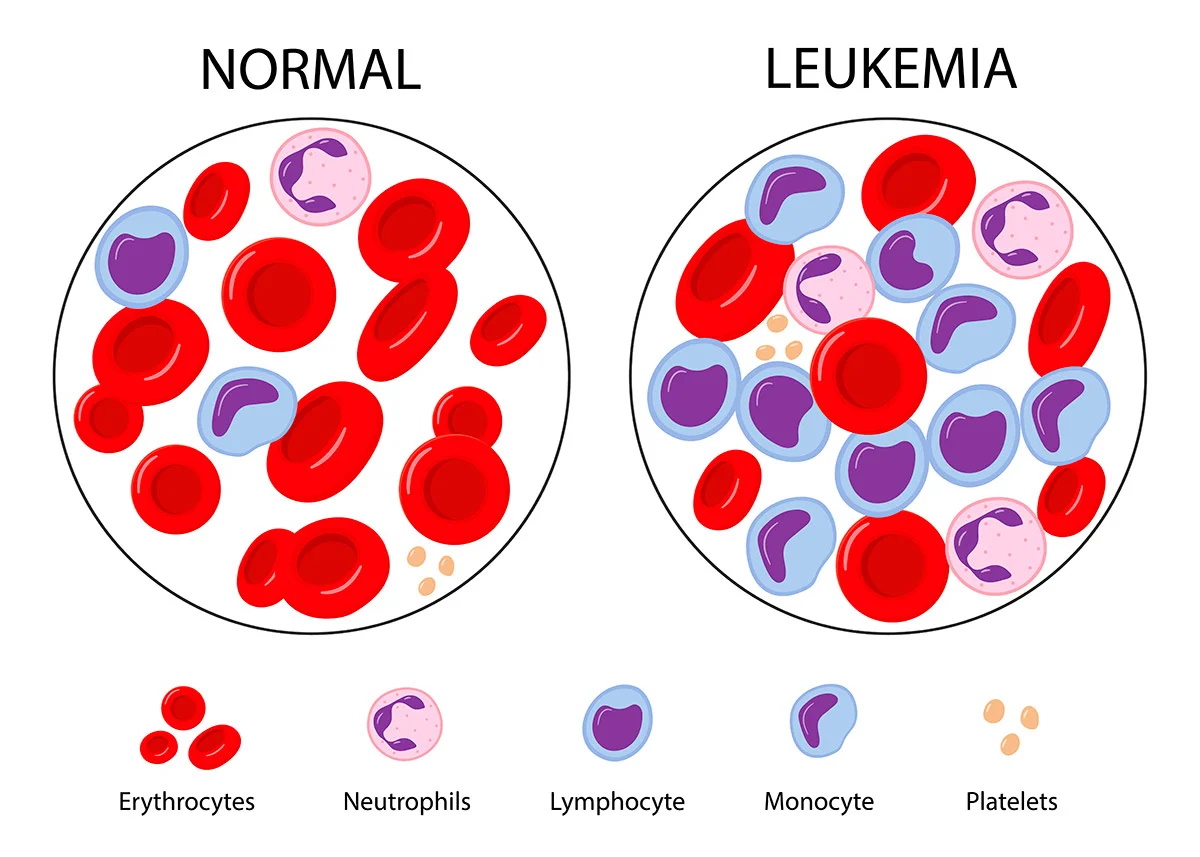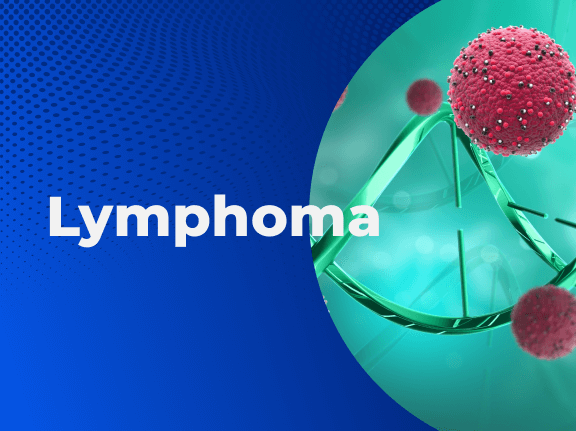Lymphoma is a cancer that starts in the cells that are part of the body’s immune system and can begin in lymph nodes in many parts of the body. There are five different types:
- Hodgkin Lymphoma (HL): begins in white blood cells called lymphocytes, usually B lymphocytes, which make proteins called antibodiesto help protect the body from germs (bacteria and viruses).
- Non-Hodgkin Lymphoma (NHL): begins in white blood cells called lymphocytes but differs from HL and is much more common.
- Non-Hodgkin Lymphoma in Children: this cancer is rare in children but does occur.
- Lymphoma of the Skin: rare lymphomas begin in the skin and are referred to as cutaneous lymphomas.
- Waldenstrom Macroglobuliemia: is a type of NHL that makes large amounts of an abnormal protein called macroglobulin.
Lymphoma Symptoms
The most common symptom of lymphoma is a lump under the skin, usually in the neck, under the arm, or in the groin. This is caused by an enlarged lymph node that does not hurt, and might get bigger over time, or new lumps might appear elsewhere. Swollen lymph nodes are more often caused by infection but react differently. When they swell due to infection, they usually hurt when touched, and go away when the infection does. Less common symptoms caused by lymphoma include: fever without infection, drenching night sweats, quick unintentional weight loss, itching fatigue, and loss of appetite. Finally, if lymphoma affects lymph nodes in the chest, this can lead to coughing, and trouble breathing. Sometimes, lymphomas do not cause any symptoms until they’ve grown quite large. Many of the symptoms can also be caused by other conditions but should be checked by a doctor to determine the cause
Common signs and symptoms are determined by the location of the lymphoma in the body and include:
- Enlarged lymph nodes
- Chills
- Weight loss
- Fatigue (feeling very tired)
- Swollen abdomen (belly)
- Feeling full after only a small amount of food
- Chest pain or pressure
- Shortness of breath or cough
- Severe or frequent infections
- Easy bruising or bleeding
Lymphoma Diagnosis
There are no screening tests to detect lymphoma early. The best way to find lymphoma early is to look out for possible symptoms – specifically enlarged lymph nodes that do not cause pain.
Most people who have a lymphoma see a doctor because of a lump that won’t go away, or because they do not feel well. Confirming a lymphoma diagnosis will then begin with a medical exam of the lymph nodes and other parts of the body that might be infected including the spleen and liver. The doctor might also order blood tests to look for signs of infection or other problems.
Methods to diagnose lymphoma
- Biopsies: If lymphoma is suspected, the doctor might recommend a biopsy of the swollen lymph node. This involves taking either a small piece of the lymph node or the entire lymph node and testing it in a lab for any abnormalities. A pathologist (doctor trained to recognize cancer cells) will look at the sample under a microscope to determine the cause.
- Imaging tests: doctors may use x-rays, sound waves, magnetic fields, or radioactive particles to make pictures of the inside of the body and might include chest x-rays, CT scans, MRIs, PET scans, and bone scans. These can be used to look for causes of symptoms, to determine the stage of the lymphoma, to show if treatment is working, or to look at any returning cancer after treatment.
- Blood tests: these are not used to diagnose lymphoma but can help to determine how advanced the cancer is how the patient will tolerate certain treatments.

Lymphoma Risk Factors
Researchers have found several factors that can affect a person’s chance of getting NHL and HL, but it is not always clear why these risk factors increase risk. Having these risk factors does not guarantee cancer either. Factors include but are not limited to:
- Epstein-Barr virus infection/mononucleosis (HL only): The Epstein-Barr virus causes infectious mononucleosis (mono). People who have had mono have an increased risk of getting HL, but it’s still a small risk (1 in 1,000).
- Age: HL can be diagnosed at any age, but it’s most common in early adulthood (20s) and late adulthood (after age 55). NHL is most common for people in their 60s and older.
- Gender: lymphomas occur slightly more often in males than in females, but there are certain types of NHL that are more common in females than males.
- Race, ethnicity, and geography (NHL only): in the US, whites develop HL at higher rates than African Americans and Asian Americans, and NHL is more common in developed countries worldwide.
- Family history: People with a first degree relative (parent, child, sibling) with NHL are at higher risk of developing NHL, and brothers and sisters of young people with the disease have a higher risk for HL. Identical twins have a very high risk of both getting HL, but it is not clear why.
- Having a weakened immune system: People with weakened immune systems have a higher risk of developing HL and NHL. Examples of this include people with HIV, who have received organ transplants, or inherited syndromes that affect the immune system.
- Other possible risk factors for NHL include obesity, exposure to certain drugs and chemicals, and having breast implants.
Lymphoma Stages
After someone is diagnosed with lymphoma, doctors will try to figure out if it has spread, and if so, how far. This process is called staging. The stage of a cancer describes how much cancer is in the body. There are 4 stages, written with roman numerals.
Stage I: the lymphoma is in only 1 lymph node area or lymphoid organ such as the tonsils or the cancer is found only in 1 area of a single organ outside of the lymph system.
Stage II: The lymphoma is in 2 or more groups of lymph nodes on the same side of (above or below) the diaphragm or the lymphoma is in a group of lymph node(s) and in one area of a nearby organ.
Stage III: The lymphoma is in lymph node areas on both sides of (above and below) the diaphragm or the lymphoma is in lymph nodes above the diaphragm, as well as in the spleen.
Stage IV: The lymphoma has spread widely into at least one organ outside the lymph system, such as the bone marrow, liver, or lung.
Lymphoma Treatment
Lymphoma treatments depend on several factors and which type of lymphoma the patient has. The most common treatments are chemotherapy and radiation therapy, and depending on the case, one or both treatments will be used. Certain patients with HL are treated with immunotherapy or with a stem cell transplant, especially when other treatment hasn’t worked. Surgery is rarely used as a treatment option for HL. Treatments for NHL include the same treatment options, but also include targeted therapy drugs, and sometimes surgery.
Lymphoma Clinical Trials
Clinical trials for cancer patients offer access to new studies that are not widely available. Massive Bio guides patients through the most comprehensive clinical trial matching process. Participating in a clinical trial provides patients with new studies they would otherwise not have access to. If you want to learn more about clinical trials for lymphoma, you can consult the team at Massive Bio.





